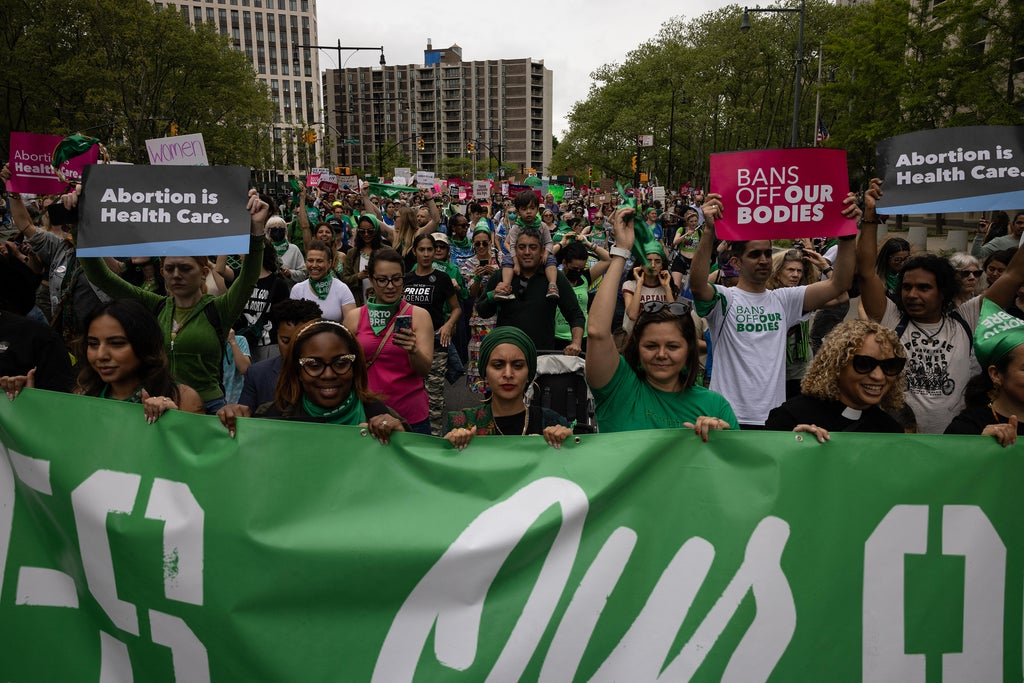Roe v. Wade has been overturned. As activists across the country rally to protest, a new symbol has emerged in the fight for abortion rights: the green scarf.
Over the past few months, following the release of a leaked Supreme Court draft opinion in early May that revealed that Roe v. Wade would likely be overturned, activists held protests that called for attendees to “bring your green bandana,” with many sporting green scarves on their wrists and necks.
While the green scarf may be the new symbol of the pro-abortion fight in the U.S, it’s been around for at least a decade. In fact, it emerged in Argentina in the late 2010s, as the country’s activists fought to decriminalize abortion in a sweeping movement that earned them the title “Marea Verde” or “Green Wave.”

What is the history of the green scarf at protests?
When the Campaña Nacional por el Derecho al Aborto (National Campaign For the Right To Abortion), which was first launched in 2005, started to organize, to push for the decriminalization of abortion in Argentina, they looked back at the “Madres de Plaza de Mayo” (“Mothers of Plaza de Mayo”), grandmothers and mothers who wore white scarves and protested the disappearance of almost 30,000 people under the dictatorship of Jorge Rafael Videla in the ‘70s. (The Campaña Nacional por el Derecho al Aborto in Argentina did not respond to requests for an interview.) “They selected green as the color of health and hope,” says Mariana Ardila, a Colombia-based managing attorney at Women’s Link Worldwide.
The movement started gaining momentum in 2015 when the #NiUnaMenos (Not One Woman Less) went viral demanding lawmakers enact policy to protect women amid an alarmingly high rate of femicides in the country. Three years later, the “Marea Verde” formed, after millions of activists, many wearing green scarves, marched in the streets of Argentina to support the legalization of abortion. “[The green scarf] slowly started showing up in other countries in the Latin American region, and it’s now a symbol in the fight for reproductive rights,” says Ardila.
What has the “green wave” accomplished in the past?
The sight of throngs of people wearing green made a visual statement, but it also propelled progress in reproductive rights across South America, Latin America, and the Caribbean. By 2020, Argentina legalized abortion in the first 14 weeks of pregnancy. In Colombia, abortion became legal up to 24 weeks of pregnancy in 2022. (That said, five countries in Latin America still have a complete ban on abortion, including Dominican Republic, Haiti, El Salvador, Honduras, and Nicaragua.)
As the green scarf made its way from country to country, the symbol has also stirred controversies. In 2019, an artist in Argentina showed a sculpture of a Virgin Mary with the green scarf covering her neck and mouth, inciting opposition from citizens who asked the museum’s curator to remove the piece from the government-sponsored art center in Buenos Aires. That same year, Puerto Rico Senator Maria de Lourdes Santiago claimed that Senate officials were interfering with the First Amendment when they asked activists — who sat in public hearings regarding abortion legislation, wearing the green scarf — to leave the room. Meanwhile, in 2019, Mexican senator Lilly Téllez called the piece of cloth a symbol of “death” in front of green scarf-clad colleagues in the Senate. (The office of Senator Lilly Téllez has not responded to a request for comment from Refinery29.)

What does the green scarf mean at protests in the United States?
Now, the green scarf has made its way from the protests on the streets to the United States Congress. Last week, New York Congresswoman Nydia Velazquez wore the symbol around her neck when she joined other Democratic members of the House to march to the Senate, ahead of the latest effort to protect Roe v. Wade, which didn’t pass.
“I wanted to send a message to women across the U.S. and Latin America marching together with the same goal in mind: protecting our right to choose. The plight is the same, that safe, legal, and accessible abortions is a fundamental right for women,” Velazquez said via email. “I specifically want to relay the message to women of all ages across the world who might be scared by what they are seeing in the United States, that we stand firm behind a woman’s right to choose what happens to their body and I will keep marching because we will never go back.”
Velazquez said she first learned about the “Green Wave” in 2019, when she was following the fight for abortion rights in Argentina, and has since witnessed how the wave has spread across Latin America and the Caribbean. “Even on my home island of Puerto Rico, the movement is expanding and growing in strength, thanks to the strong advocacy of young women,” she says.
Velazquez recognizes that the work in Latin America is inspiring a new generation of activists in the United States. “The work that has been done by tireless advocates throughout Latin America is sparking waves of progress on women’s access to reproductive health care throughout the globe,” says Velazquez. “If the United States wants to remain a leader on the world stage, we cannot marginalize women by allowing Roe v. Wade to fall and banning access to a safe abortion.”
As protests across the United States continue, the green scarf will not only serve as a symbol of resistance but transnational solidarity between the Americas. Together, we fight.
Like what you see? How about some more R29 goodness, right here?
Roe v. Wade Will Likely Be Overturned. Now What?




